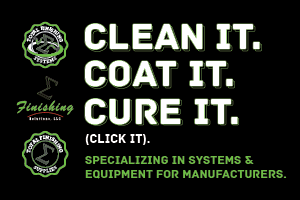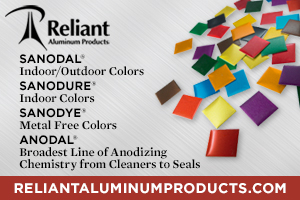At some point, every manufacturer faces problems that develop in its process.
 Eric Svenson Sr.This could be due to outdated equipment or procedures, expanding production needs, the loss of expertise when a key employee leaves, or a host of other reasons. If the company has the technical staff with that specialized knowledge, these issues can be resolved in-house.
Eric Svenson Sr.This could be due to outdated equipment or procedures, expanding production needs, the loss of expertise when a key employee leaves, or a host of other reasons. If the company has the technical staff with that specialized knowledge, these issues can be resolved in-house.
If not, it’s time to consider bringing in an outside Technical Advisor with the needed skillset.
Facing the Predicament
We use the phrase Technical Advisor instead of a consultant because many seem opposed to the term. It’s human nature to try solving problems independently and resist seeking outside expertise. Sometimes, it’s difficult to admit that an outside expert could easily and quickly resolve the issue.
There’s a better approach, and ignoring the issue only ‘kicks the can down the road’ while the problem continues to manifest; the result is often:
- Rejection rates are expanding.
- Rework costs are increasing.
- Deliveries are being delayed.
- Customers are becoming frustrated.
- Sales and profits are declining.
None of these issues is good for business, its stability, or growth. A company dealing with these concerns often experiences several of these problems.
A plating reject isn’t just a wasted effort because stripping and replating costs at least three (3) times what it should have been. The cost is even higher if rejected after the second or third attempt. If this is the case, the costs could increase by as much as tenfold.
The inability to produce parts that meet the specification ends up being very costly. It’s much more than just having to rework several times and accepting the higher operational costs because this defect also affects other business areas.
Outside Expertise
Every business manager wants to eliminate high rework levels. The time to bring in an outside Technical Advisor when in-house solutions haven’t proven successful. An expert in that field will identify the core problem(s) and their cause(s) and provide direction for resolving the issues. They can also identify problematic areas that you may not be aware of.
Technical Advisors provide specialized knowledge, expert advice, and an objective perspective on complex issues. They help companies identify problems, develop strategies, implement solutions, and achieve corporate goals more effectively. They offer a fresh look at things that may have gone unnoticed, make recommendations on issues that were not considered before, and can help businesses navigate unfamiliar areas like launching a new project.
They are often hired to solve a specific problem or set of problems. Afterward, having a Technical Advisor ‘on call’ can be a critical business asset. They are already familiar with your operation and could provide immediate assistance whenever needed as new technical issues arise.
They are an invaluable resource without the long-term cost of hiring a highly paid employee with these skills, assuming you could find one. The value of hiring a Technical Advisor is getting fast results for less money.
Typical Problem Areas
There are many areas where a Technical Advisor can provide significant benefits to a manufacturing or plating operation; these include:
- Increasing production and throughput.
- Lowering operational costs.
- Solving specific plating problems.
- Reducing stripping and rework rates.
- Improving overall deposit quality.
- Increasing plating bath efficiency.
- Managing impurities within tolerable limits.
- Plating bath maintenance and control.
- Anoding and fixturing issues.
- Rectifier, ventilation, or agitation problems.
- Resolving environmental issues.
- Expanding production without busting the budget.
- Revamping and updating the production equipment.
Industry Examples
Here are examples where using a Technical Advisor delivered significant benefits and provided considerable ongoing savings:
(1) An OEM operation making hydraulic rods used an antiquated system built around 1965 and never revamped to newer technologies. They could not maintain production due to increased sales due to inefficiency, breakdowns, and maintenance issues. Their Technical Advisor assessed the situation and designed a modern system using today’s standards that increased production capabilities, lowered the maintenance requirements, and provided much better environmental standards.
(2) A job shop plater was falling behind on production because their #1 customer doubled the number of parts needed daily. That’s a good problem to have, but they needed help identifying the best approach to increasing output by 100% without making a massive capital investment. After assessing the operation, the Technical Advisor had them modify their bath chemistry, operating parameters, and anode configurations. This increased their efficiency to the point that their production capacity more than doubled.
(3) A machine manufacturer struggled to successfully plate their tooling in-house. Their production demand was five sets per shift, and they needed to target output to at least seven sets. Due to plating quality issues, they were only producing three sets per shift, so they needed an increase of more than 200%. The Technical Advisor recommended converting an idle tank to production, increasing their rectifier capacity, and making minor process changes. Their throughput increased by over 300%, giving them a comfortable margin for future growth.
(4) Another job shop plater had difficulty finding workers with the needed skillsets to operate and maintain their plating lines. This resulted in quality and production problems that declined to the point where they lost their core customers. A Technical Advisor was hired to evaluate the operation and train their operators on two shifts. A lead plater who received additional training on bath analysis and maintenance was then selected. The job shop kept its core customers while taking on some new and profitable business.
(5) A large manufacturer lost their lead plating foreman to retirement after 40 years of service. Unfortunately, he was the only one who knew the various procedures, leaving their crew without the expertise to produce good parts. They had little knowledge about their processes, the baths, anoding, stop-off, fixtures or maintaining the equipment. The result was that both the plating quality and the production capacity declined, and their only recourse was to send their parts out for plating. This caused their costs to skyrocket drastically, cutting into their profits. Their Technical Advisor made minor changes to the operation, drafted new work instructions, trained their workers, and established a new lead plater. Their work is now 100% plated in-house, their product quality has improved, and their operational costs are lower than ever.
Cost Justification
It’s difficult to put an exact dollar amount on the benefit a Technical Advisor can bring because each operation and its problems are different. However, every company above realized a very significant return on their investment. This resulted from several key areas:
- Improvements in product quality.
- Meeting production requirements.
- Reducing operating costs.
- Upgrading equipment and processes.
- Streamlining maintenance procedures.
- Eliminating environmental issues.
- Training the workforce.
It’s hard to put a price tag on those benefits, but they clearly exceed the cost of hiring a Technical Advisor by a huge margin. In several cases, they saved companies from losing their most valuable customers and income base.
Using a Technical Advisor is a low-risk and high-reward undertaking. Their expertise and knowledge base are part of their trade, filling gaps that employees can’t provide. Overall, their cost is well spent because the rewards are ongoing.
Approach
A Technical Advisor should approach a project using the following sequence:
- Establish goals
- Identify the core problem(s)
- Collect data
- Diagnose the issues
- Provide Information
- Make recommendations
- Implement improvements
- Educate employees
Qualifications
It may not be an easy task to find a Technical Advisor capable of solving your issues. They tend to specialize in specific and often very narrow areas. A particular talent or combination of talents related to your needs is required. A suitable Technical Advisor should have the following qualities:
- Expertise in your particular area of concern.
- Years of experience solving similar issues.
- Strong analytical and problem-solving skills.
- Critical thinking abilities.
- Excellent communication skills.
- Dedicate the needed time and resources.
- Include operator training if needed.
- Provide a positive cost/reward value.
The decision to seek outside assistance is easy, given the high cost of production and the fast return on the investment.
Eric Svenson Sr. is CEO of Plating Resources and a Master CEF and IUSF member. Visit www.Plating.com. If you have any questions or wish to explore this topic further, please contact Vicky at Vicky@Plating.com.



































